Annotated Bibliography: Historical Analysis of the Conquest of Israel
VerifiedAdded on 2023/06/10
|5
|1034
|332
Annotated Bibliography
AI Summary
This annotated bibliography examines the Conquest of Israel in 722 BC through a selection of five key sources. Bleibtreu (1991) analyzes Assyrian records of torture and death, providing insights into the siege of Israel. Finkelstein (2008) studies the settlement history of Jerusalem, offering evidence sup...
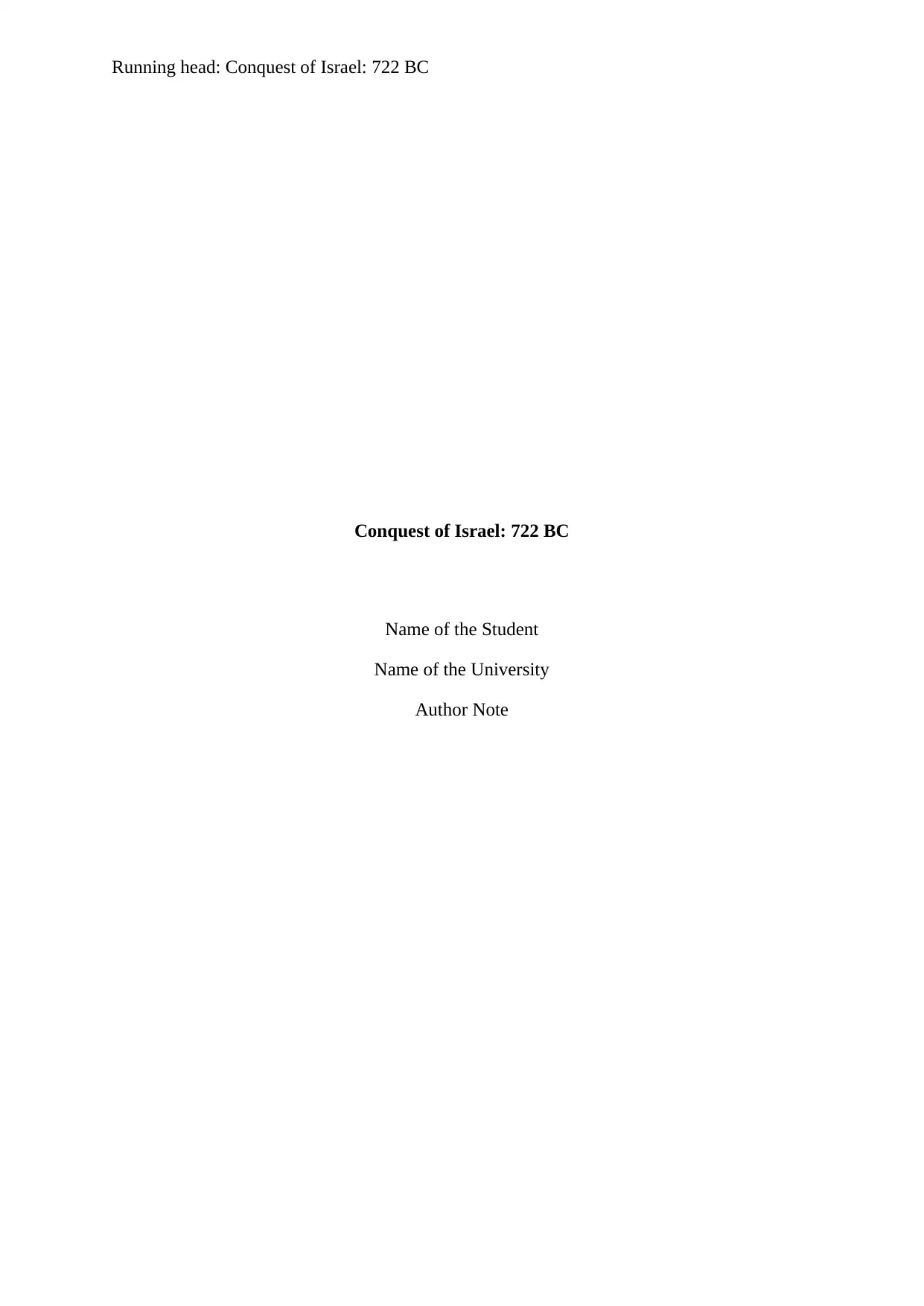
Running head: Conquest of Israel: 722 BC
Conquest of Israel: 722 BC
Name of the Student
Name of the University
Author Note
Conquest of Israel: 722 BC
Name of the Student
Name of the University
Author Note
Paraphrase This Document
Need a fresh take? Get an instant paraphrase of this document with our AI Paraphraser
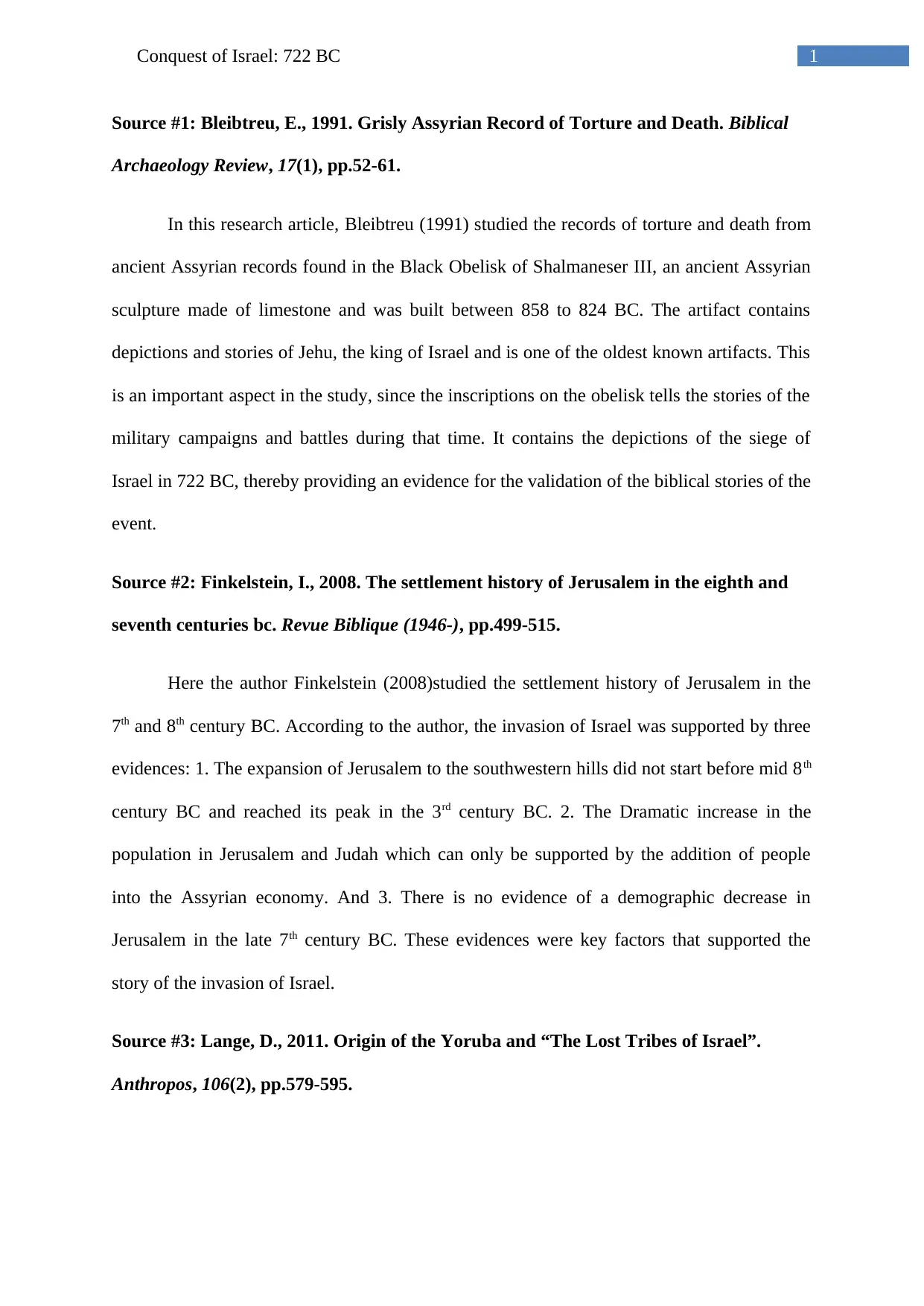
1Conquest of Israel: 722 BC
Source #1: Bleibtreu, E., 1991. Grisly Assyrian Record of Torture and Death. Biblical
Archaeology Review, 17(1), pp.52-61.
In this research article, Bleibtreu (1991) studied the records of torture and death from
ancient Assyrian records found in the Black Obelisk of Shalmaneser III, an ancient Assyrian
sculpture made of limestone and was built between 858 to 824 BC. The artifact contains
depictions and stories of Jehu, the king of Israel and is one of the oldest known artifacts. This
is an important aspect in the study, since the inscriptions on the obelisk tells the stories of the
military campaigns and battles during that time. It contains the depictions of the siege of
Israel in 722 BC, thereby providing an evidence for the validation of the biblical stories of the
event.
Source #2: Finkelstein, I., 2008. The settlement history of Jerusalem in the eighth and
seventh centuries bc. Revue Biblique (1946-), pp.499-515.
Here the author Finkelstein (2008)studied the settlement history of Jerusalem in the
7th and 8th century BC. According to the author, the invasion of Israel was supported by three
evidences: 1. The expansion of Jerusalem to the southwestern hills did not start before mid 8th
century BC and reached its peak in the 3rd century BC. 2. The Dramatic increase in the
population in Jerusalem and Judah which can only be supported by the addition of people
into the Assyrian economy. And 3. There is no evidence of a demographic decrease in
Jerusalem in the late 7th century BC. These evidences were key factors that supported the
story of the invasion of Israel.
Source #3: Lange, D., 2011. Origin of the Yoruba and “The Lost Tribes of Israel”.
Anthropos, 106(2), pp.579-595.
Source #1: Bleibtreu, E., 1991. Grisly Assyrian Record of Torture and Death. Biblical
Archaeology Review, 17(1), pp.52-61.
In this research article, Bleibtreu (1991) studied the records of torture and death from
ancient Assyrian records found in the Black Obelisk of Shalmaneser III, an ancient Assyrian
sculpture made of limestone and was built between 858 to 824 BC. The artifact contains
depictions and stories of Jehu, the king of Israel and is one of the oldest known artifacts. This
is an important aspect in the study, since the inscriptions on the obelisk tells the stories of the
military campaigns and battles during that time. It contains the depictions of the siege of
Israel in 722 BC, thereby providing an evidence for the validation of the biblical stories of the
event.
Source #2: Finkelstein, I., 2008. The settlement history of Jerusalem in the eighth and
seventh centuries bc. Revue Biblique (1946-), pp.499-515.
Here the author Finkelstein (2008)studied the settlement history of Jerusalem in the
7th and 8th century BC. According to the author, the invasion of Israel was supported by three
evidences: 1. The expansion of Jerusalem to the southwestern hills did not start before mid 8th
century BC and reached its peak in the 3rd century BC. 2. The Dramatic increase in the
population in Jerusalem and Judah which can only be supported by the addition of people
into the Assyrian economy. And 3. There is no evidence of a demographic decrease in
Jerusalem in the late 7th century BC. These evidences were key factors that supported the
story of the invasion of Israel.
Source #3: Lange, D., 2011. Origin of the Yoruba and “The Lost Tribes of Israel”.
Anthropos, 106(2), pp.579-595.
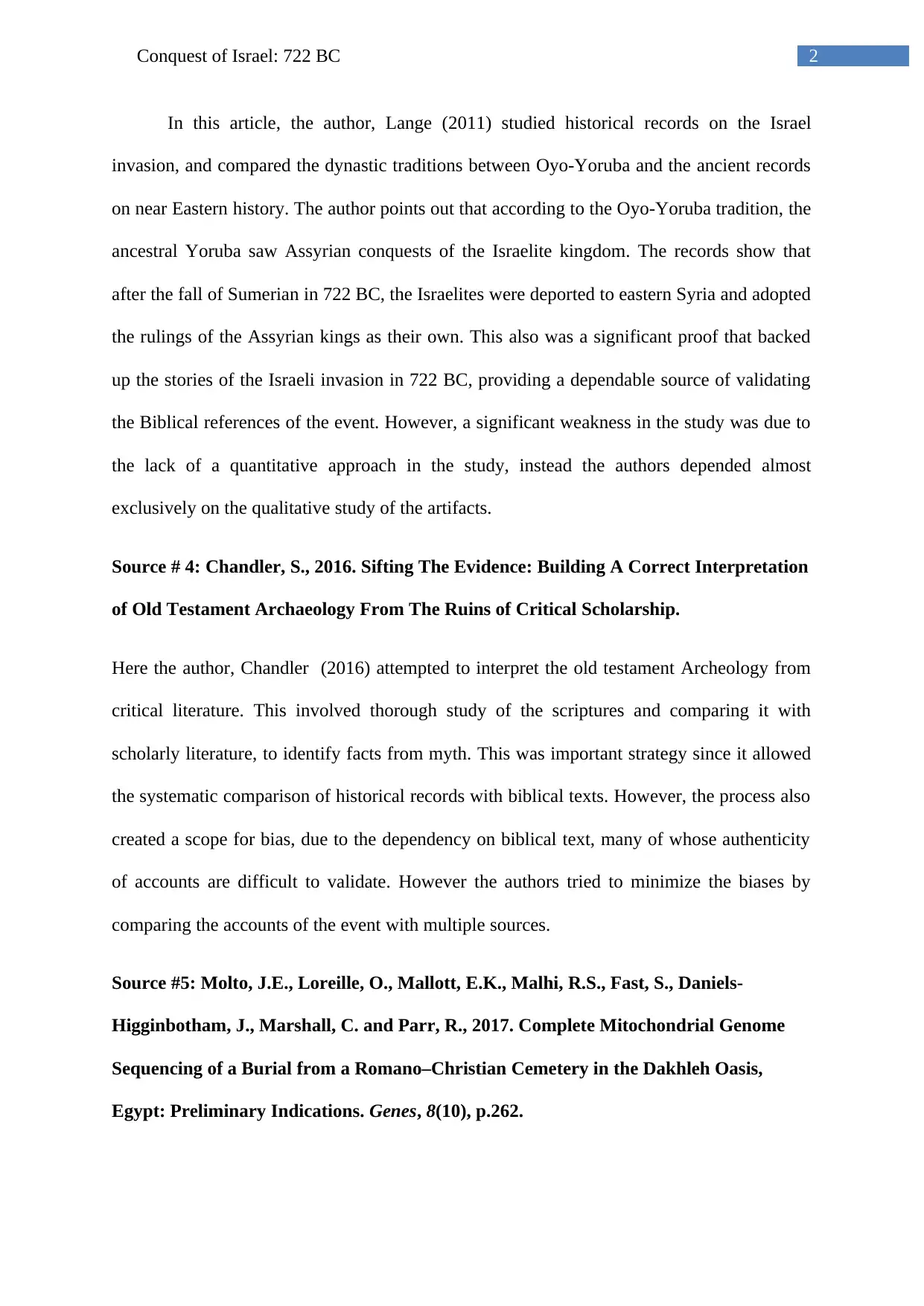
2Conquest of Israel: 722 BC
In this article, the author, Lange (2011) studied historical records on the Israel
invasion, and compared the dynastic traditions between Oyo-Yoruba and the ancient records
on near Eastern history. The author points out that according to the Oyo-Yoruba tradition, the
ancestral Yoruba saw Assyrian conquests of the Israelite kingdom. The records show that
after the fall of Sumerian in 722 BC, the Israelites were deported to eastern Syria and adopted
the rulings of the Assyrian kings as their own. This also was a significant proof that backed
up the stories of the Israeli invasion in 722 BC, providing a dependable source of validating
the Biblical references of the event. However, a significant weakness in the study was due to
the lack of a quantitative approach in the study, instead the authors depended almost
exclusively on the qualitative study of the artifacts.
Source # 4: Chandler, S., 2016. Sifting The Evidence: Building A Correct Interpretation
of Old Testament Archaeology From The Ruins of Critical Scholarship.
Here the author, Chandler (2016) attempted to interpret the old testament Archeology from
critical literature. This involved thorough study of the scriptures and comparing it with
scholarly literature, to identify facts from myth. This was important strategy since it allowed
the systematic comparison of historical records with biblical texts. However, the process also
created a scope for bias, due to the dependency on biblical text, many of whose authenticity
of accounts are difficult to validate. However the authors tried to minimize the biases by
comparing the accounts of the event with multiple sources.
Source #5: Molto, J.E., Loreille, O., Mallott, E.K., Malhi, R.S., Fast, S., Daniels-
Higginbotham, J., Marshall, C. and Parr, R., 2017. Complete Mitochondrial Genome
Sequencing of a Burial from a Romano–Christian Cemetery in the Dakhleh Oasis,
Egypt: Preliminary Indications. Genes, 8(10), p.262.
In this article, the author, Lange (2011) studied historical records on the Israel
invasion, and compared the dynastic traditions between Oyo-Yoruba and the ancient records
on near Eastern history. The author points out that according to the Oyo-Yoruba tradition, the
ancestral Yoruba saw Assyrian conquests of the Israelite kingdom. The records show that
after the fall of Sumerian in 722 BC, the Israelites were deported to eastern Syria and adopted
the rulings of the Assyrian kings as their own. This also was a significant proof that backed
up the stories of the Israeli invasion in 722 BC, providing a dependable source of validating
the Biblical references of the event. However, a significant weakness in the study was due to
the lack of a quantitative approach in the study, instead the authors depended almost
exclusively on the qualitative study of the artifacts.
Source # 4: Chandler, S., 2016. Sifting The Evidence: Building A Correct Interpretation
of Old Testament Archaeology From The Ruins of Critical Scholarship.
Here the author, Chandler (2016) attempted to interpret the old testament Archeology from
critical literature. This involved thorough study of the scriptures and comparing it with
scholarly literature, to identify facts from myth. This was important strategy since it allowed
the systematic comparison of historical records with biblical texts. However, the process also
created a scope for bias, due to the dependency on biblical text, many of whose authenticity
of accounts are difficult to validate. However the authors tried to minimize the biases by
comparing the accounts of the event with multiple sources.
Source #5: Molto, J.E., Loreille, O., Mallott, E.K., Malhi, R.S., Fast, S., Daniels-
Higginbotham, J., Marshall, C. and Parr, R., 2017. Complete Mitochondrial Genome
Sequencing of a Burial from a Romano–Christian Cemetery in the Dakhleh Oasis,
Egypt: Preliminary Indications. Genes, 8(10), p.262.
⊘ This is a preview!⊘
Do you want full access?
Subscribe today to unlock all pages.

Trusted by 1+ million students worldwide
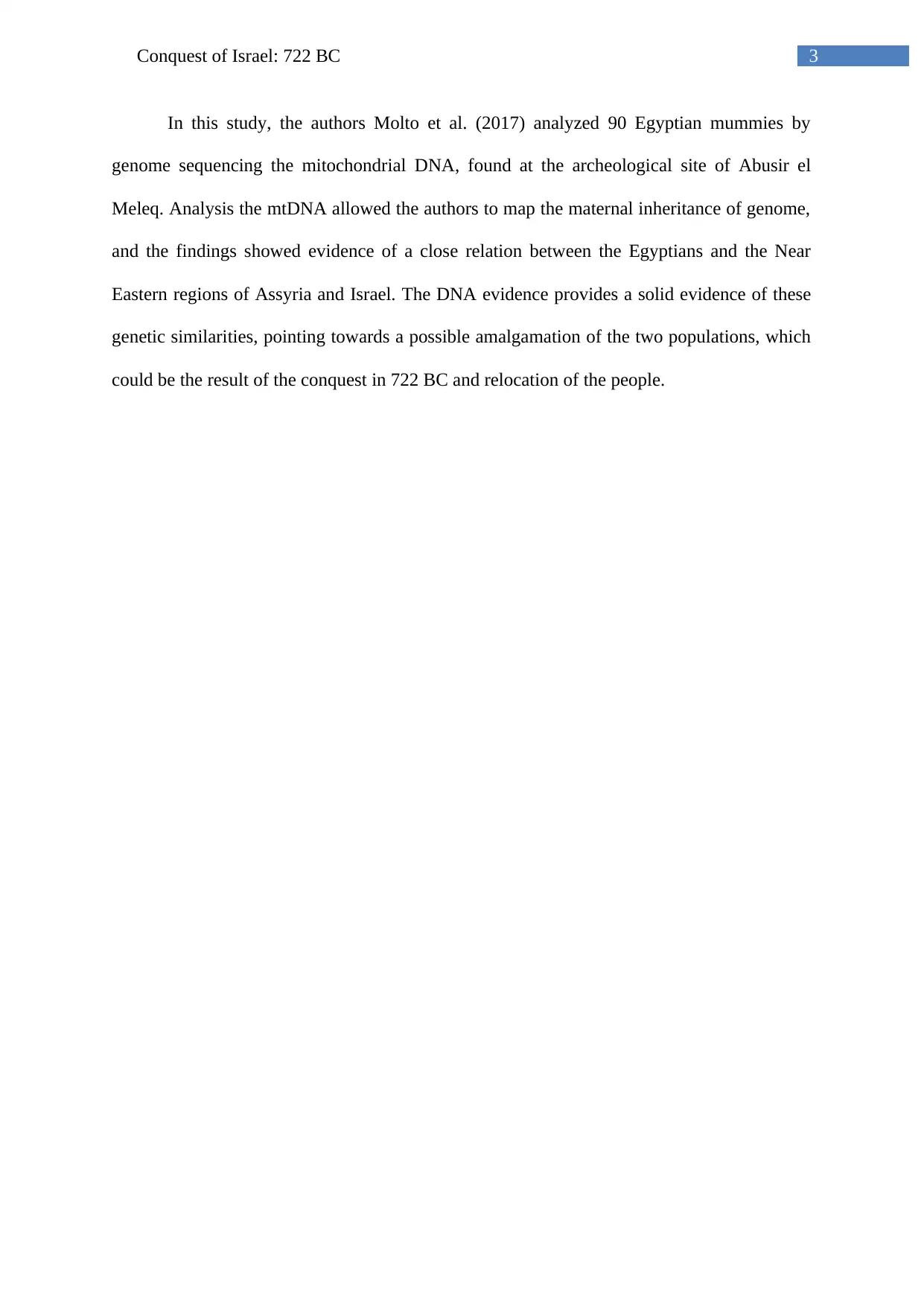
3Conquest of Israel: 722 BC
In this study, the authors Molto et al. (2017) analyzed 90 Egyptian mummies by
genome sequencing the mitochondrial DNA, found at the archeological site of Abusir el
Meleq. Analysis the mtDNA allowed the authors to map the maternal inheritance of genome,
and the findings showed evidence of a close relation between the Egyptians and the Near
Eastern regions of Assyria and Israel. The DNA evidence provides a solid evidence of these
genetic similarities, pointing towards a possible amalgamation of the two populations, which
could be the result of the conquest in 722 BC and relocation of the people.
In this study, the authors Molto et al. (2017) analyzed 90 Egyptian mummies by
genome sequencing the mitochondrial DNA, found at the archeological site of Abusir el
Meleq. Analysis the mtDNA allowed the authors to map the maternal inheritance of genome,
and the findings showed evidence of a close relation between the Egyptians and the Near
Eastern regions of Assyria and Israel. The DNA evidence provides a solid evidence of these
genetic similarities, pointing towards a possible amalgamation of the two populations, which
could be the result of the conquest in 722 BC and relocation of the people.
Paraphrase This Document
Need a fresh take? Get an instant paraphrase of this document with our AI Paraphraser
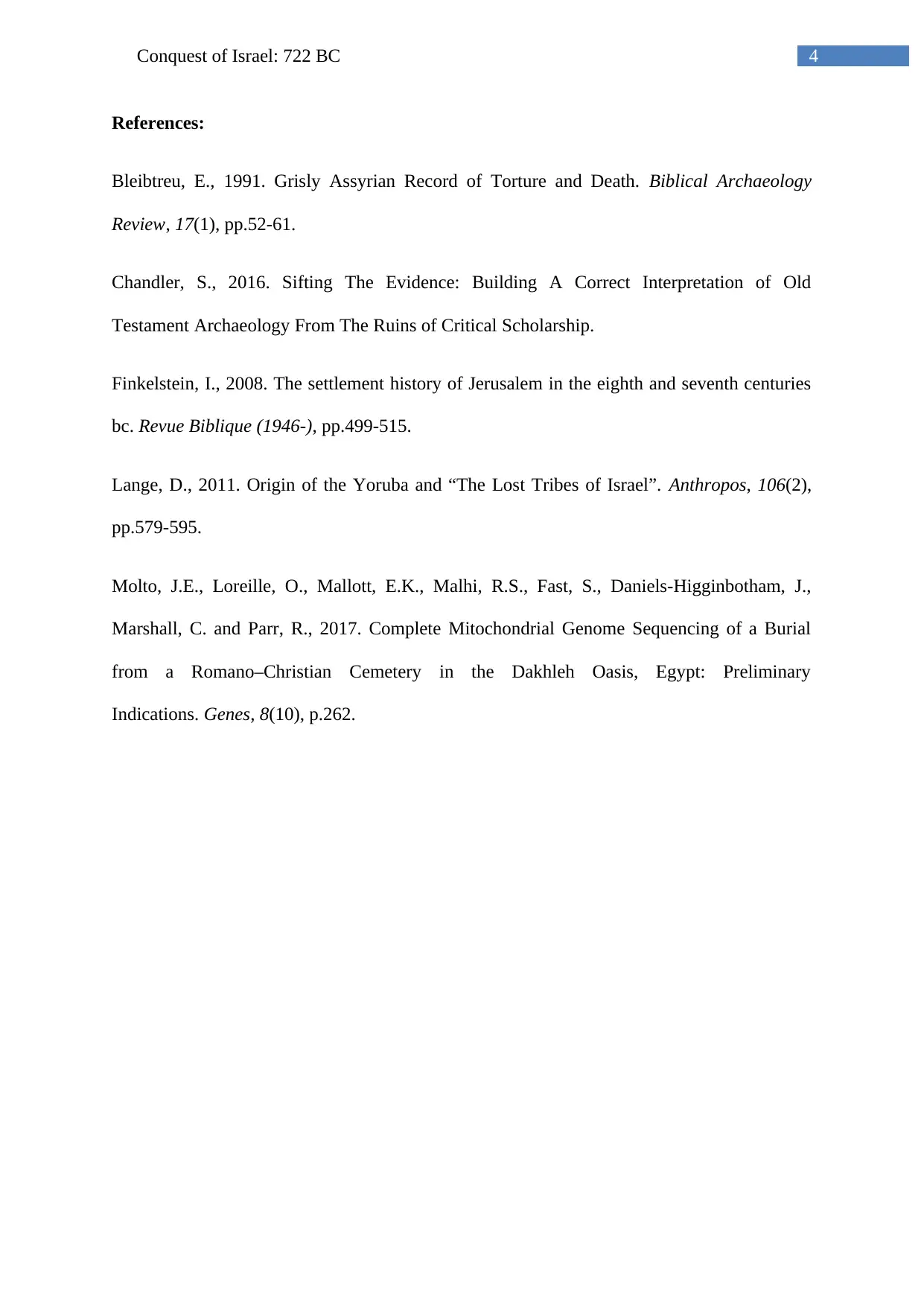
4Conquest of Israel: 722 BC
References:
Bleibtreu, E., 1991. Grisly Assyrian Record of Torture and Death. Biblical Archaeology
Review, 17(1), pp.52-61.
Chandler, S., 2016. Sifting The Evidence: Building A Correct Interpretation of Old
Testament Archaeology From The Ruins of Critical Scholarship.
Finkelstein, I., 2008. The settlement history of Jerusalem in the eighth and seventh centuries
bc. Revue Biblique (1946-), pp.499-515.
Lange, D., 2011. Origin of the Yoruba and “The Lost Tribes of Israel”. Anthropos, 106(2),
pp.579-595.
Molto, J.E., Loreille, O., Mallott, E.K., Malhi, R.S., Fast, S., Daniels-Higginbotham, J.,
Marshall, C. and Parr, R., 2017. Complete Mitochondrial Genome Sequencing of a Burial
from a Romano–Christian Cemetery in the Dakhleh Oasis, Egypt: Preliminary
Indications. Genes, 8(10), p.262.
References:
Bleibtreu, E., 1991. Grisly Assyrian Record of Torture and Death. Biblical Archaeology
Review, 17(1), pp.52-61.
Chandler, S., 2016. Sifting The Evidence: Building A Correct Interpretation of Old
Testament Archaeology From The Ruins of Critical Scholarship.
Finkelstein, I., 2008. The settlement history of Jerusalem in the eighth and seventh centuries
bc. Revue Biblique (1946-), pp.499-515.
Lange, D., 2011. Origin of the Yoruba and “The Lost Tribes of Israel”. Anthropos, 106(2),
pp.579-595.
Molto, J.E., Loreille, O., Mallott, E.K., Malhi, R.S., Fast, S., Daniels-Higginbotham, J.,
Marshall, C. and Parr, R., 2017. Complete Mitochondrial Genome Sequencing of a Burial
from a Romano–Christian Cemetery in the Dakhleh Oasis, Egypt: Preliminary
Indications. Genes, 8(10), p.262.
1 out of 5
Your All-in-One AI-Powered Toolkit for Academic Success.
+13062052269
info@desklib.com
Available 24*7 on WhatsApp / Email
![[object Object]](/_next/static/media/star-bottom.7253800d.svg)
Unlock your academic potential
© 2024 | Zucol Services PVT LTD | All rights reserved.